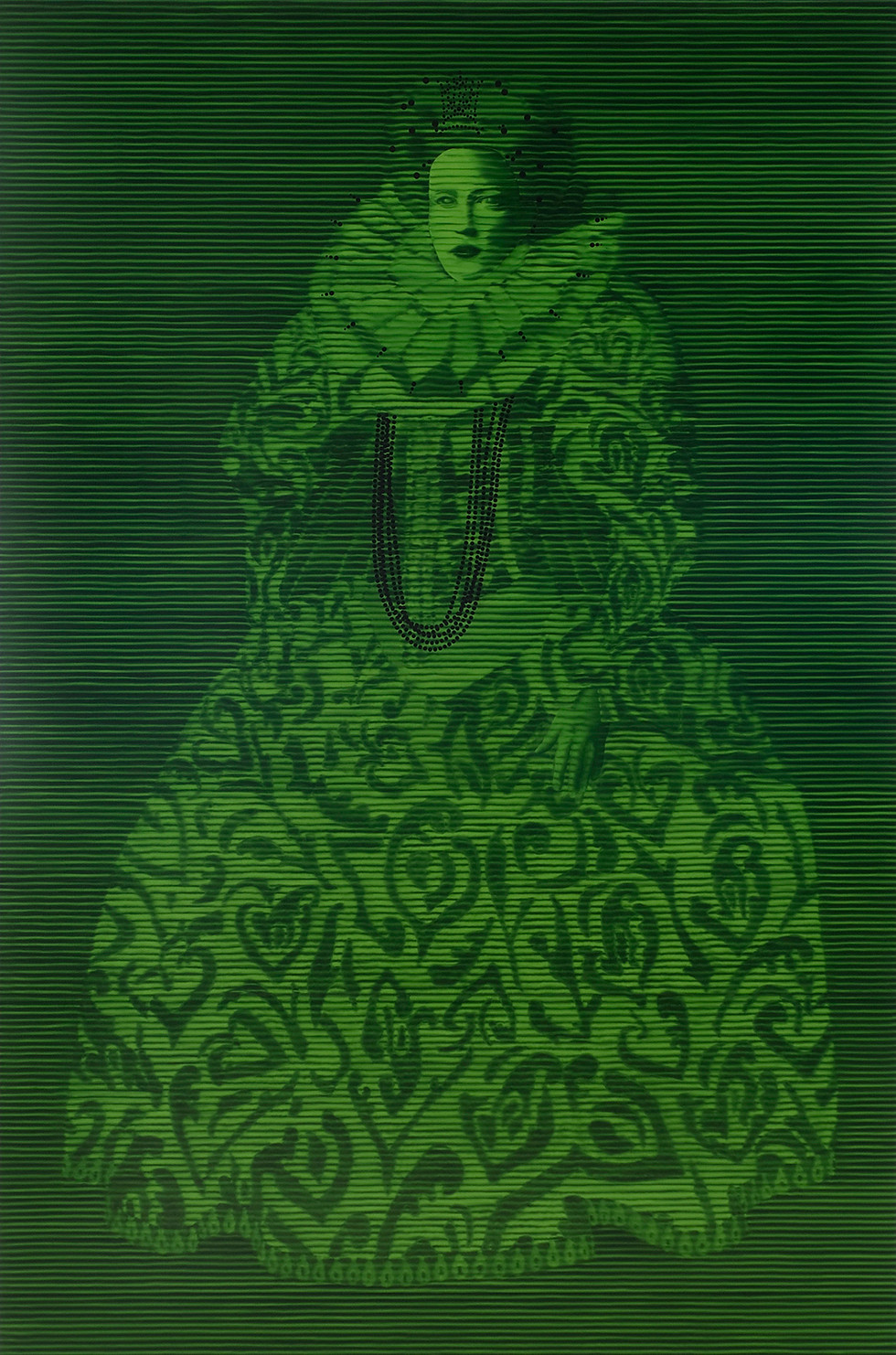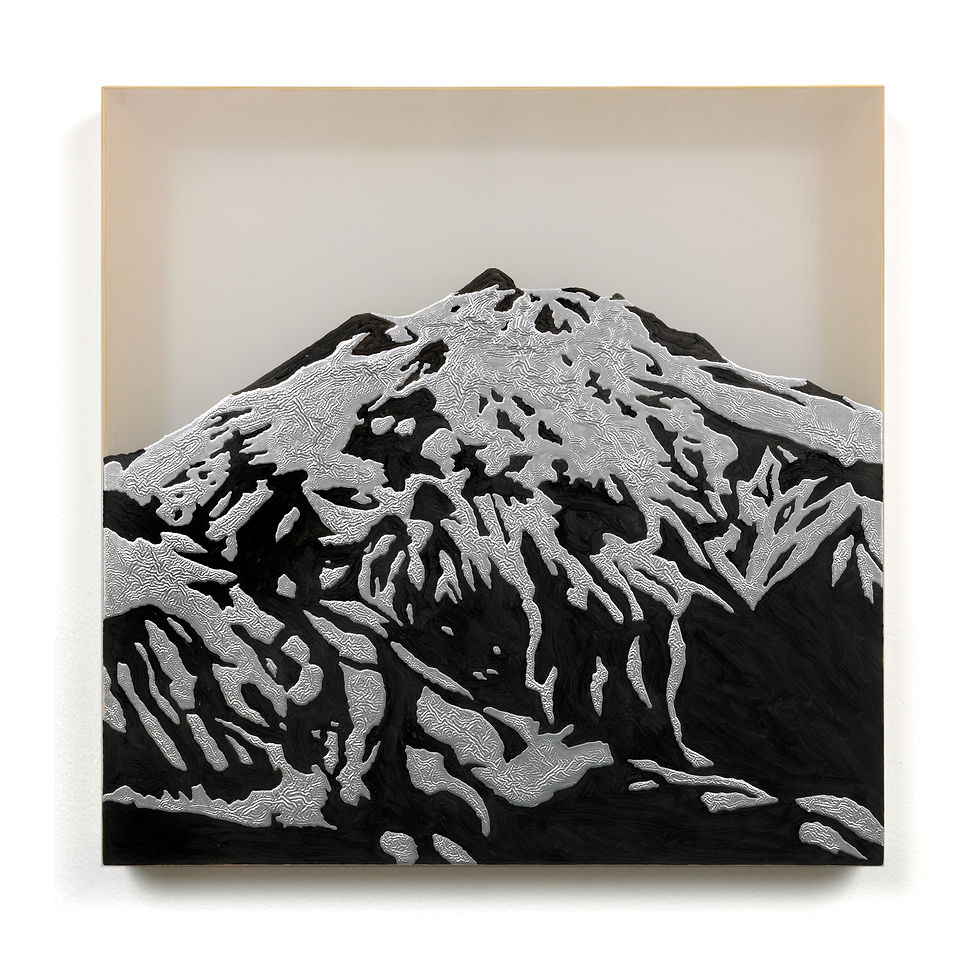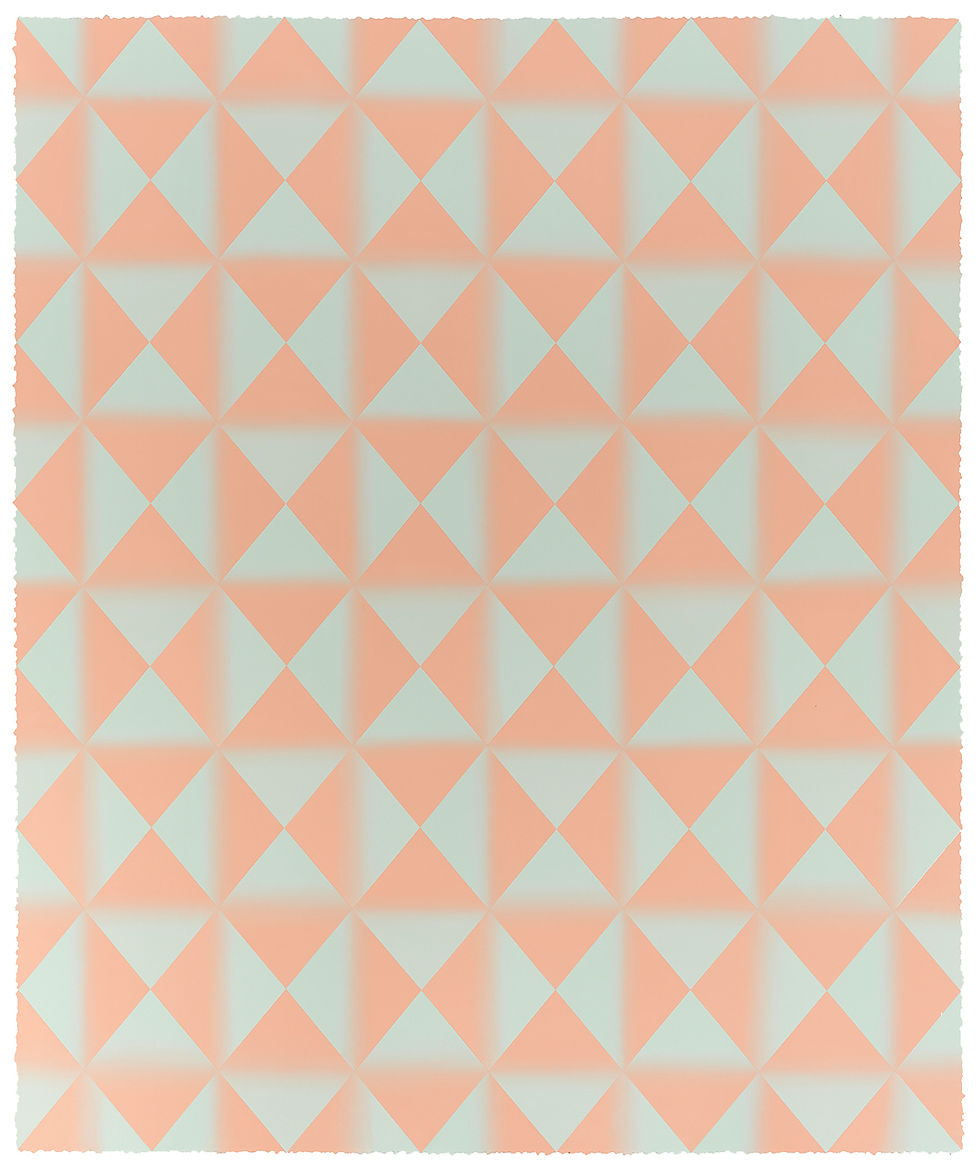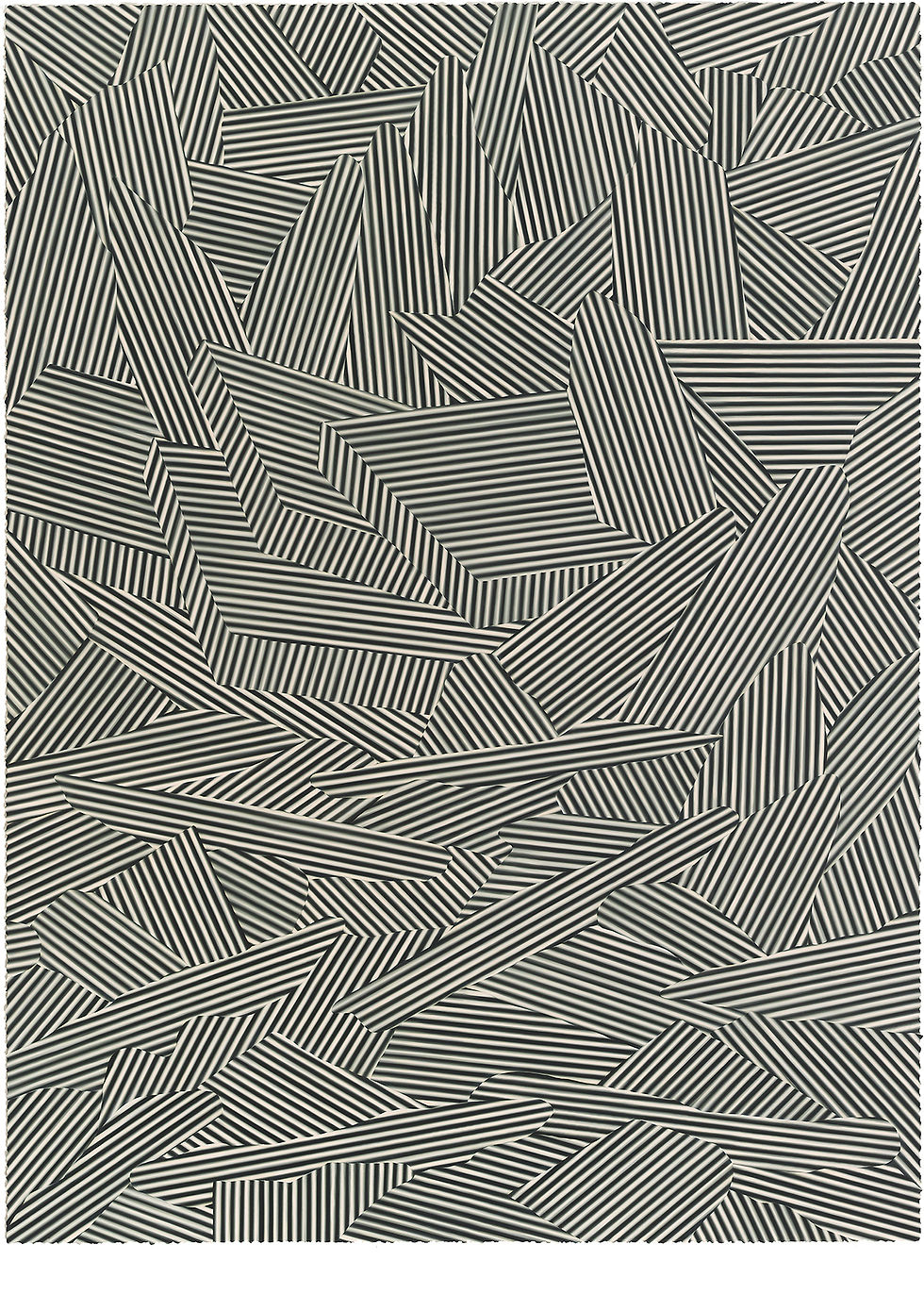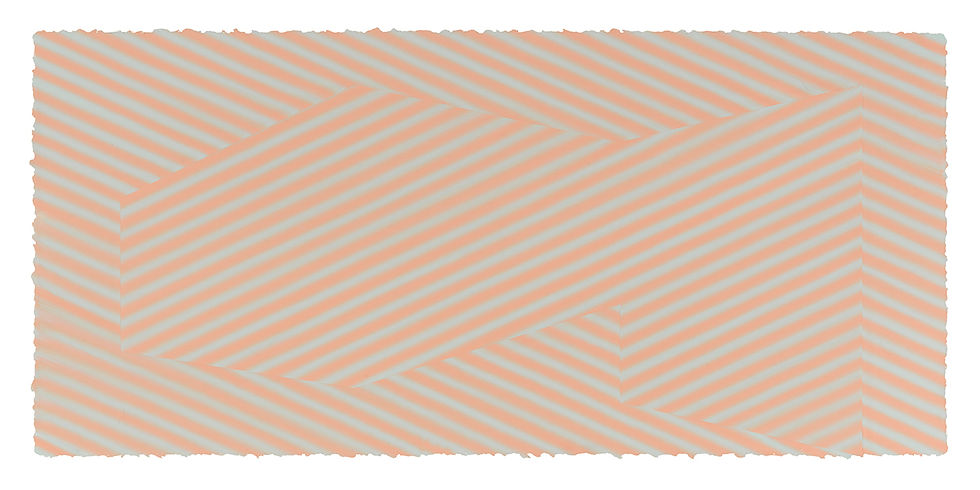Optical considerations in my recent painting
April 29, 2020
My recent untitled painting has several optical considerations that utilize different and sometimes competing visual codes. The painting is comprised of three base colors and all the colors that can be mixed between two of the base colors (there is not a three-way mixture of color). The painting in general has a light color, a medium (warmish) grey color and dark color. I have adjusted the grey slightly darker so grey groups with the darker color. This means because of the area painted the painting is more or less balanced between light and dark. The light color in the pattern is the same area as the dark color and grey color combined (photo 1, detail of painting).
I try to maintain the pattern and the location of the color by careful blending. In other words, sometimes, the colors are delineated by sharp lines and sometimes they are blended. Where they are blended the “sum” of the color remains the same. The lighter color goes though a gradual mix with the darker color but the amount of color (lightness and darkness) remains unchanged. This matters because at a distance the pattern asserts itself (photo 2, entire painting in my studio).
It is while walking toward the painting, that the strict pattern degrades. The painting is 96” wide and 72” tall. By the time you’re between three to four feet away from the painting your cone of vision is about 90 degrees wide. This matters because it fills your peripheral vision, but I will get back to that later.
This type of pattern is a typical repeat tile pattern. It implies dimension because it can be interpreted as shaded planes depicted isometrically. Topologically speaking it is a checkerboard on a diagonal. When you get closer to the painting (and this differs dramatically from viewing online, even if you use the zoom function) there is the expectation that the details will resolve themselves and the space depicted will become more understandable or at least predictable (“getting a closer look” is something we say all the time). Getting closer to the painting reveals the blended and unblended edges. One of the things that happens is a conflicting code by the way the shapes are blended or not. With the blended shapes they seem to set up a weave, as if going under or around adjacent shapes. This is a partial code in the sense the shapes don’t reappear like the would in something woven.
I am now speculating to some extent. There is an optical diagram that I think may shed some light on my painting. (photo 3, drawing) Each end of this drawing depicts a whole three-dimensional form. It can only exist as line (it can’t be colored in). The drawing follows the rules of isometric drawing and exploits the rule of a cube form needing three lines and a cylinder only two. This drawing has always interested me because to color it in would ruin it. Color defines a plane or a cylinder which would be too much information in this drawing. Informed by this I paint untruth all over my painting (photo 4, close up).
Buried in the overall noise of the pattern of the painting are competing rectangles and rounded shapes. Sharp corners intrude on shapes that by implication should be curved and correspondingly curved shapes ignore their rectangular confines. I do this to preserve the pattern on the one hand and exploit light, shadow and dimension on the other. For me it’s the unsettledness of the painting that makes it interesting. I think we are active participants in how we see. With the barest visual evidence we will construct a pattern and with any anomaly we will look harder to see if we can incorporate it into a new understanding of the pattern.
Scott Stack
American, born 1952, lives in Oak Park, IL.
Education
1976 Minneapolis College of Art and Design, Minneapolis, MN
Selected Solo Exhibitions
2018 Interior and Exterior, Chicago Cultural Center, Chicago IL.
2011 New Paintings, Moniquemeloche Gallery, Chicago IL
2006 Night Vision Moniquemeloche Gallery, Chicago IL
1997 Thomas Barry Fine Arts, Minneapolis MN
1996 Chicago Cultural Center, Chicago IL
1995 Thomas Barry Fine Arts, Minneapolis, MN
1990 Thomas Barry Fine Arts, Minneapolis, MN
1984 White Columns, New York, NY
1981 Balkin Fine Art, Chicago, IL
1979 Macalester College, St. Paul, MN
1978 Rochester Art Center, Rochester, MN
Selected Group Exhibitions
2021 Carrie Secrist Gallery, Chicago IL.
2021 Glow, Chicago IL.
2016 New American Paintings: Midwest Edition, Elmhurst Art Museum, Elmhurst IL.
2015 Group show, Riverside Art Center. Riverside IL.
2008 Winter Experiment, Monique Meloche Gallery, Chicago IL.
2005 Mathew Girson, Scott Stack, Scott Short, Gahlberg Gallery, College of DuPage, Glen Ellyn, IL
2004 Art from Flo, Judith Racht Gallery, Halbert, MI
Fitter Happier. DePaul University Gallery, Chicago, IL
2003 Operation Human Intelligence, Hyde Park Art Center, Chicago, IL
2002 Group Show, Monique Meloche, Chicago, IL
1999 Group Show, Red Chair Gallery, Kansas City, MO
Chicago Artists, Gallery 312, Chicago, IL
1998 Ceaseless, Crown Center Gallery, Loyola University, Chicago, IL
1997 10,000 Lincoln Cheese “Logs”, Wriston Arts Center
1998 Laurence University, Appleton, WI, Hyde Park Art Center, Chicago, IL Carlton College Art Gallery, Carlton
1994 Cars, Radio’s and Other Great Stuff Stomen From Past Art Expo’s, Beret International, Chicago, IL
Chicago Curators Choose Chicago Artists, Zolla Lieberman Gallery, Chicago, IL
1992 Landscape as Object, Thomas Barry Fine Arts, Minneapolis, MN
1986 4 Painters, Soho Center for the Visual Arts, New York, NY
1981 Five Emerging Artists, Minneapolis College of Art and Design, Minneapolis, MN
1980 Scott Stack/Victor Gonchoroff, NAME Gallery, Chicago, IL
1977 5 Geniuses, MAEP Gallery, Minneapolis Institute of Art, Minneapolis, MN
Selected Bibliography
2018 Yau, John, Scott Stack Rethinks the Rules of Op Art, April 29, 2018
2006 Snodgrass, Susan. Scott Stack at Monique Meloche. Art in America, Oct, page 203
2006 Grabner, Michelle. Scott Stack Chicago. Art Papers. July/ August, page 58
2005 Molon, Dominic. Situational Painting: Matthew Girson, Scott Short, Scott Stack. College of DuPage exhibition catalog
sstack2010 [at] gmail.com | © 2022 Scott Stack
Website design and custom typeface by Sonnenzimmer
Photography by Tom Van Eynde








